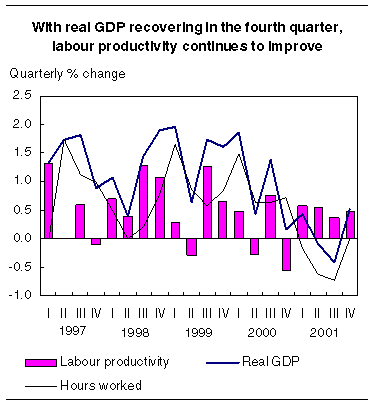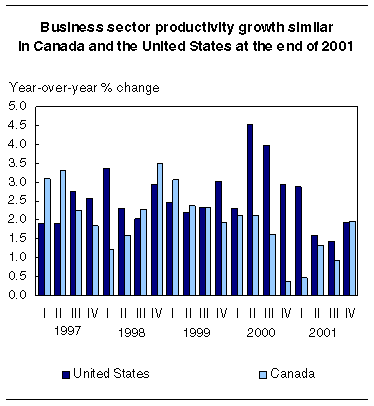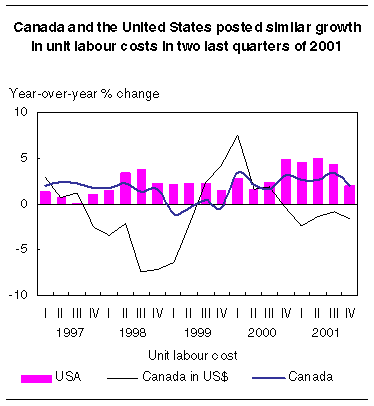
















 |
|
 |                |
Archived ContentInformation identified as archived is provided for reference, research or recordkeeping purposes. It is not subject to the Government of Canada Web Standards and has not been altered or updated since it was archived. Please "contact us" to request a format other than those available. 
The Daily. Thursday, March 14, 2002 Labour productivity, hourly compensation and unit labour costFourth quarter 2001 and annual 2001With improved economic activity, labour productivity in the business sector was up 0.5% in the fourth quarter from the third. This figure was almost identical to those for the first three quarters of 2001, which ranged from 0.4% to 0.6%. In the initial stage of the recovery, businesses tended to increase the efficiency of existing employees rather than hire new ones, which made it possible to boost output without adding hours worked. Labour force adjustments made during 2001 seem to be virtually complete. In 2001, businesses adapted to the economic slowdown by reducing the total number of hours worked, which enhanced productivity in each quarter. 
Quarterly output grows with virtually no increase in labour inputReal output grew 0.5% in the fourth quarter, after shrinking in the second and third. This growth in output occurred primarily because of stronger household expenditures. Stimulated by low interest rates, automobile sales and residential construction led the growth in demand in the fourth quarter. A slight 0.1% rise in employment was offset by a similar drop in the average number of hours worked, leaving total hours worked unchanged in the fourth quarter. Over the previous three quarters, hours worked declined. Businesses tighten their control over unit labour costOn a quarter-to-quarter basis, the unit labour cost (an indicator that measures changes in hourly compensation relative to labour productivity) fell 0.3% in the fourth quarter - the first such drop since the third quarter of 2000. The increase in hourly compensation paid to business-sector employees was limited to 0.3% in the fourth quarter, or less than half the growth rate observed in the third quarter. On a year-over-year basis, hourly compensation grew 4.0% in the fourth quarter, surpassing annual growth in productivity in that period. As a result, businesses saw their unit labour costs rise 2.0% in the fourth quarter compared with the fourth quarter of 2000. Although this was the lowest annual rate of growth since the third quarter of 2000, it was higher than the average annual increase of 1.5% posted in the second half of the 1990s. Annual average business sector productivity rises modestlyThe business sector saw annual productivity of 1.2% in 2001, a slowdown from 1.5% in 2000. The 2001 rate matches the average annual growth from 1988 to 1995, but falls short of the average annual increase of 1.7% from 1995 to 2000. The 1.2% annual rise in productivity in 2001 reflected a similar growth in output, as labour input remained unchanged. Hourly compensation paid to business-sector employees rose at an annual rate of 3.8% in 2001, after growing 4.2% in 2000. This rate is higher than the average annual rate of 3.3% posted from 1995 to 2000. Given that hourly compensation increased at a rate three times higher than productivity, the unit labour cost for the sector rose 2.7% in 2001 - a hike almost identical to that of 2000. Business sector 2001
Canada-US comparisonOn an annual basis, US productivity continued to grow more quickly than did Canada's in 2001. However, Canada maintained an advantage in unit labour costs. In 2001, labour productivity grew 1.2% in Canada and 1.9% in the United States. This 0.7% difference in favour of American businesses is in line with the average 0.9% gap per year measured since 1995. Despite Canada's softer productivity performance, lower growth in compensation paid by Canadian businesses more than offset this productivity gap. Thus, relative unit labour costs in Canada rose at an average pace that was 0.6% lower from 1995 to 2001. Year-over-year productivity rises at almost the same rate in Canada and United StatesOn a year-over-year basis, Canadian businesses realized productivity growth of 2.0% in the fourth quarter. US companies, by comparison, posted 1.9% growth in the fourth quarter. This was the first time since the third quarter of 1999 that the performance of Canadian businesses was similar to those of the United States. 
Since the first quarter of 2000, gaps in productivity growth between the two countries favoured American businesses; these differences ranged from 0.2% to 2.5% per quarter over the period. On a year-over-year basis, Canadian businesses continued to record modest increases in output in the fourth quarter, while their American counterparts saw output shrink. In the fourth quarter, output increased at an annual rate of 0.4% in Canada but declined 0.1% in the United States. Both countries' productivity was also reflected in the decrease in hours worked. On an annual basis, hours worked in the fourth quarter fell more sharply (-2.0%) in the United States than in Canada (-1.5%). Businesses in both countries, with a view to adjusting their labour needs to the drop in output, continued to reduce the total number of hours worked. Hours worked dropped for the fourth consecutive quarter in the United States and the second in Canada. Unit labour cost performance is similarOn a year-over-year basis, the growth rate for fourth-quarter hourly compensation in the business sector was identical in Canada and the United States - an annual rate of 4.0%. 
Taken together, the similar growth in productivity and the same hourly-compensation growth rate resulted in equal unit labour cost growth in the two countries in the fourth quarter. On a year-over-year basis, unit labour costs for Canadian and American businesses both grew 2.0% in the fourth quarter, when measured in their respective national currencies. However, Canadian businesses still have an advantage when the unit labour cost is adjusted for the exchange rate. Measured in US dollars, Canada's unit labour cost actually fell 1.6% in the fourth quarter. Given the rise in unit labour cost posted in the United States in the fourth quarter, Canadian businesses improved their comparative costs 3.6%, down from 5.1% posted in the third quarter. Available on CANSIM: table 383-0008. A technical note on quarterly estimates of labour productivity is available on request. To obtain a copy, e-mail to productivity.measures@statcan.gc.ca. For more information, or to enquire about the concepts, methods or data quality of this release, contact Jean-Pierre Maynard (613-951-3654; fax: 613-951-5403; maynard@statcan.gc.ca), Micro-Economic Analysis Division. Canada's business sector: Labour productivity and related variables
Canada and the United States: Business sector's labour productivity and related variables
| |||||||||||||||||||||||||||||||||||||||||||||||||||||||||||||||||||||||||||||||||||||||||||||||||||||||||||||||||||||||||||||||||||||||||||||||||||||||||||||||||||||||||||||||||||||||||||||||||||||||||||||||||||||||||||||||||||||||||||||||||||||||||||||||||||||||||||||||||||||||||||||||||||||||||||||||||||||||||||||||||||||||||||||||||||||||||||||||||||||||||||||||||||||||||||||||||||||||||||||||||||||||||||||||||||||||||||||||||||||||||||||||||||||||||||||||||||||||||||||||||||||||||||||||||||||||||||||||||||||||||||||||||||||||||||||||||||||||||||||||||||||||||||||||||||||||||||||||||||
|
|
|